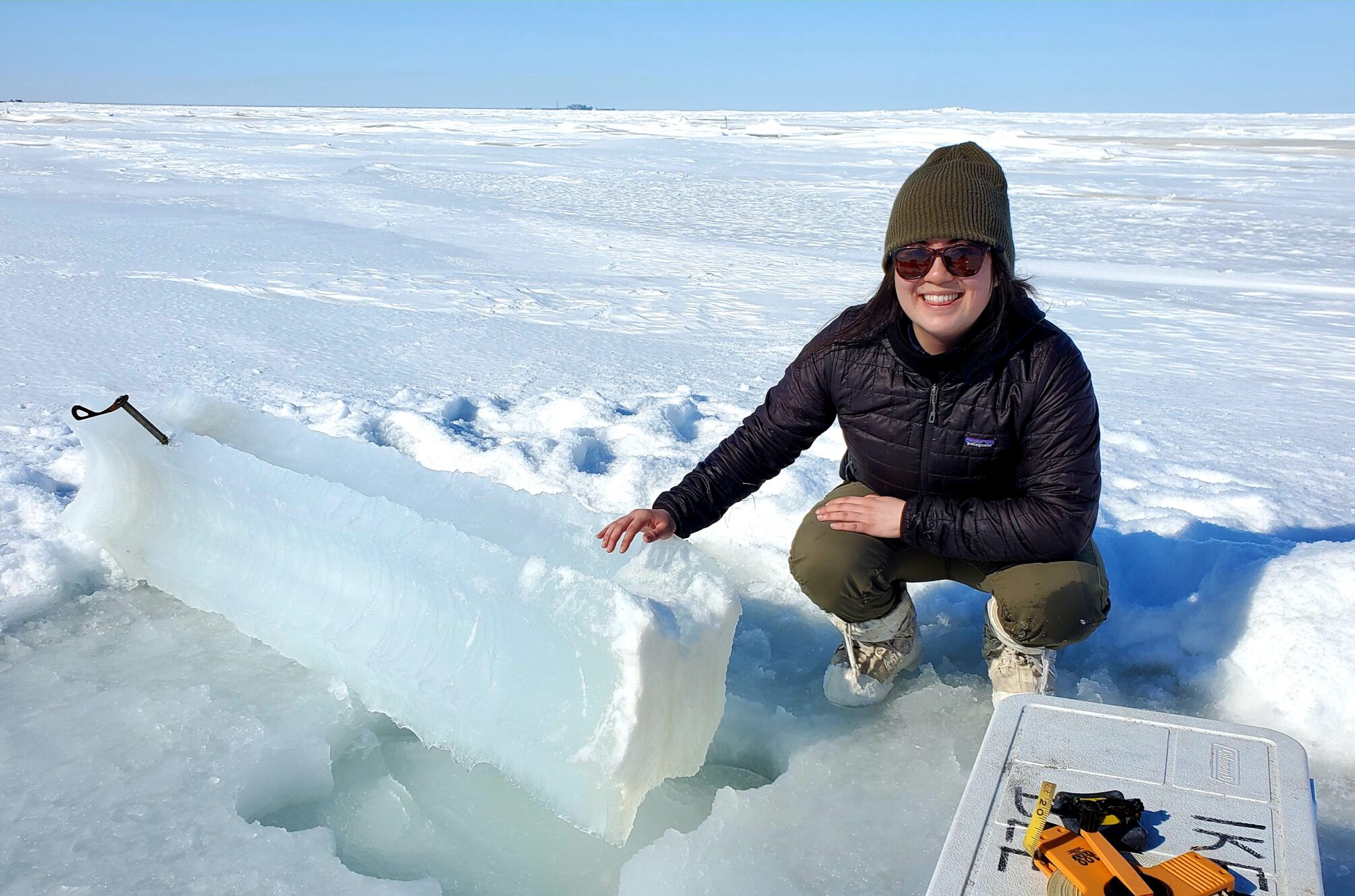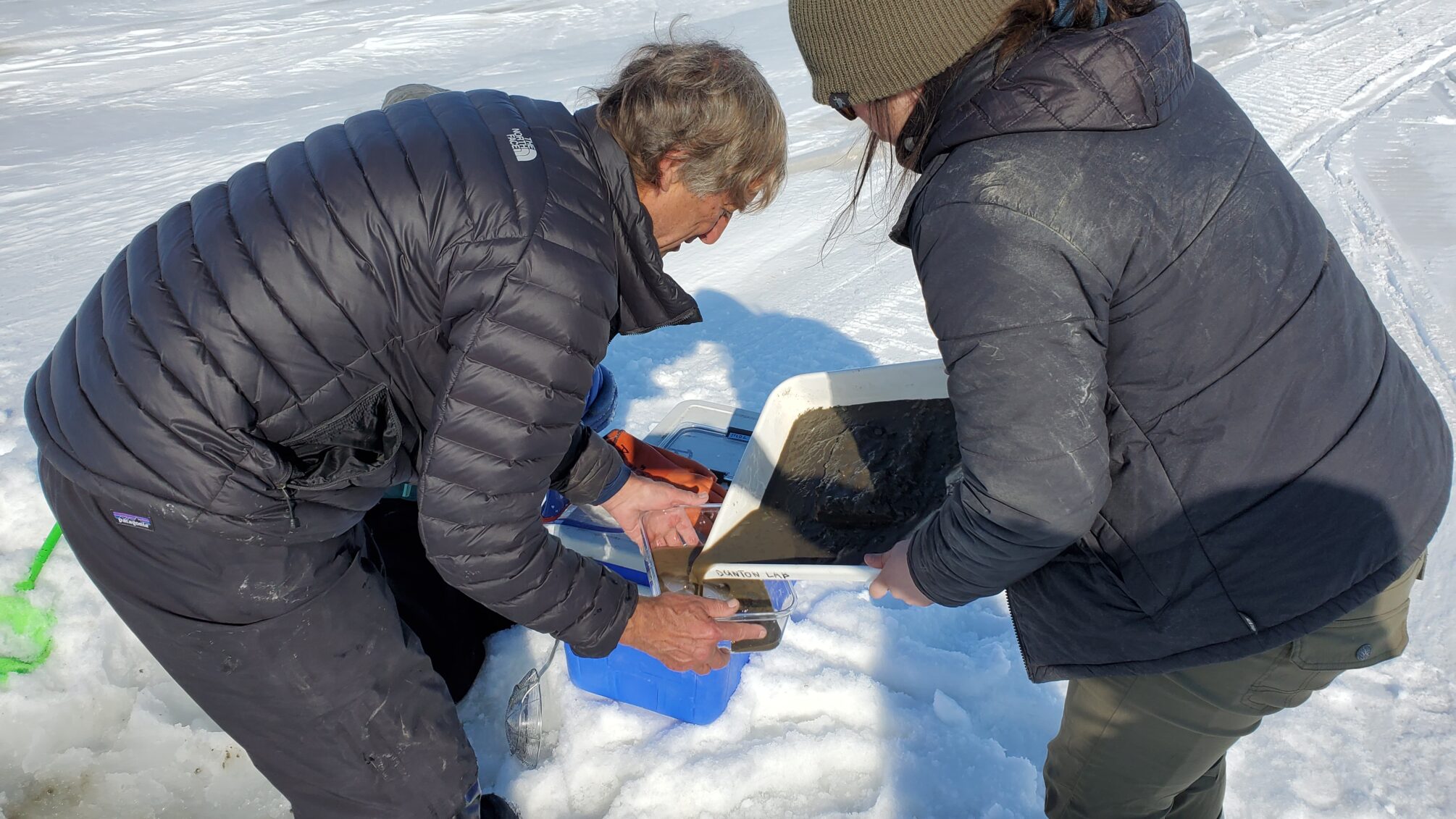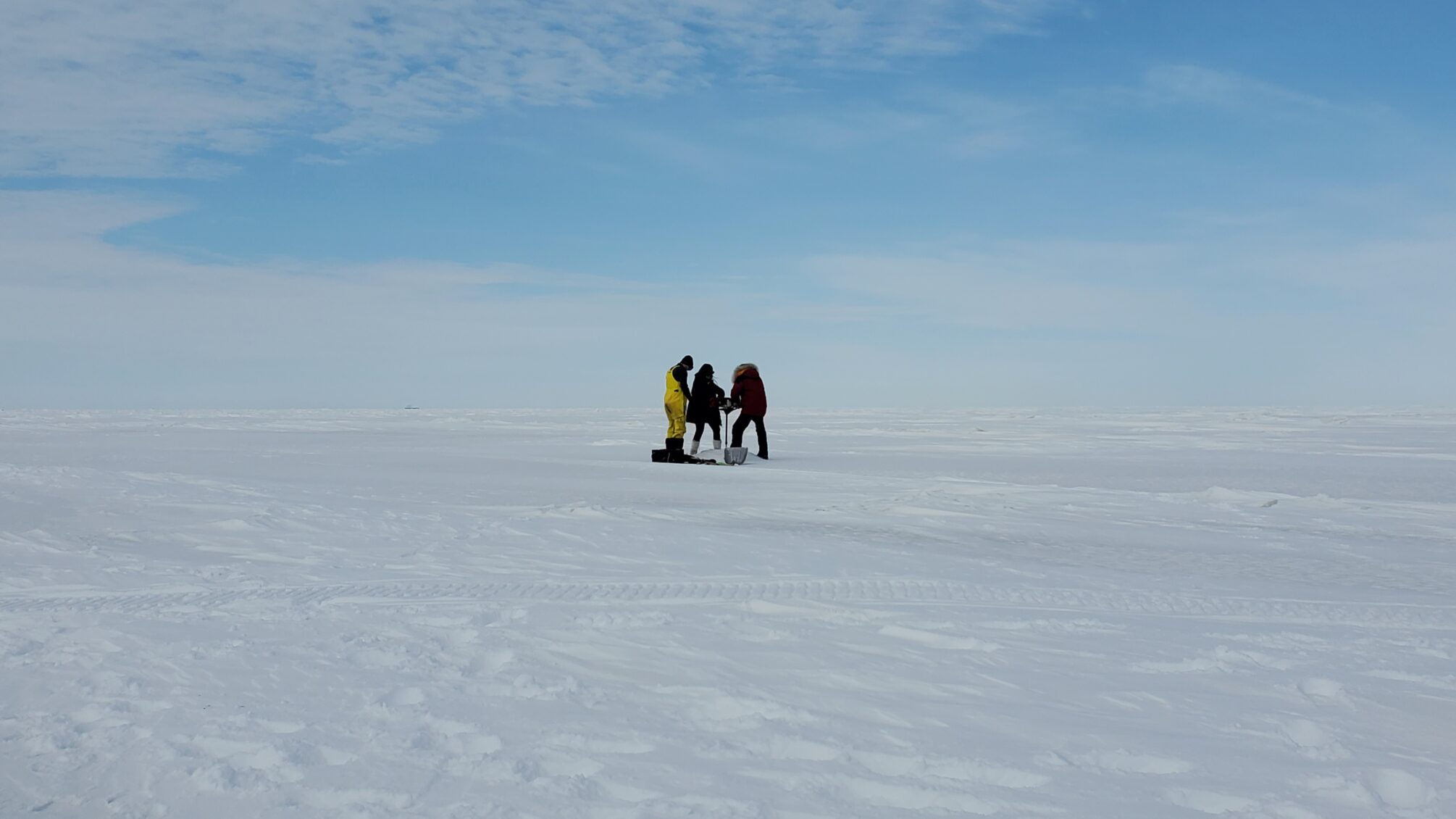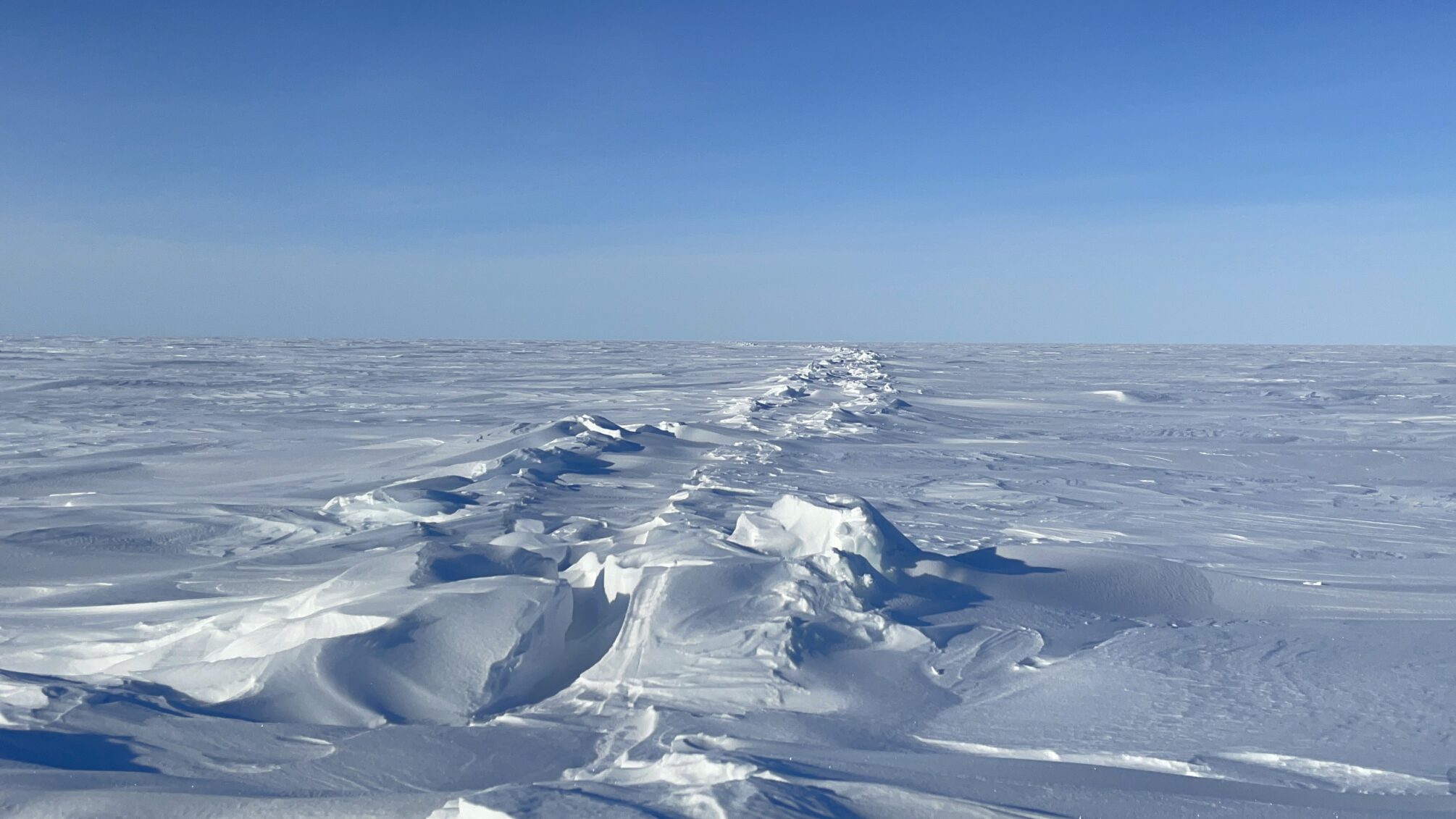
Sydney Wilkinson and Dr. Ken Dunton use an ice corer to drill into the sea ice to sample the ice and create holes to sample the lagoons. Credit: James Schloemer (2021) CC BY-SA 4.0
Credit: James Schloemer
By Alina Spera, PhD Candidate at the University of Texas at El Paso
In Arctic lagoons, life persists through cold and dark winters, but few people are able to study and understand the bizarre life under sea ice. With chemical biomarkers and insight from local communities, food web ecologists are beginning to uncover how these organisms thrive in the harsh winter, and how they will continue to survive in the ever changing Arctic climate.
Bundled and excited
Out on the desolate sea ice covering Simpson Lagoon near Deadhorse, Alaska, a small group of ecology researchers are clustered around snow machines and sleds packed with a mountain of gear. The horizon is dotted with pressure ridges and snow drifts that built up over the winter, and the group looks happily at the rare blue sky peaking through the clouds.
As the people move around, the wind packed snow squeaks with each step, their feet barely sinking into the snow surface. Even though their faces are obscured under a few layers, the researchers can barely conceal their excitement to finally reach this site, many miles from home, and come face to face with the mysterious organisms beneath their feet.
Sydney Wilkinson’s smile stands out as she begins to unpack the sleds. As a PhD student and food web ecologist at the University of Alaska at Fairbanks, Sydney works for the Beaufort Lagoons Ecosystem Long Term Ecological Research program (BLE-LTER) in the North Slope region of Alaska.
The BLE-LTER project focuses on 5 lagoon systems in 3 locations across the northernmost coastline in the United States. These lands are the traditional home of Inupiat people, who have been stewards of Alaskan Arctic environments for millenia. The communities rely on the lagoons to provide habitat and rich hunting grounds for economically important species of fish, marine mammals, and waterfowl.
The deep connection between local communities and the coastal land and waters not only feeds people and fuels the economy of the region, but makes up a major part of their cultural heritage and identity. Climate warming and regional environmental change threaten the livelihoods of people who live in the Arctic. Sydney’s work, which monitors organic matter flow through Arctic lagoon ecosystems and predicts how the systems will respond to environmental change, has direct implications for local communities.

Sydney Wilkinson poses next to a block of sea ice. Credit: James Schloemer (2021) CC BY-SA 4.0.
Credit: James Schloemer
What lives under all that ice?
One might ask a sensible question: “What creatures could these ecologists possibly be studying in the frozen lagoons?” The answer is that a vibrant community of microbes, algae, and animals live in the Beaufort lagoons, where they survive a large part of the year trapped beneath 6 feet of sea ice.
Simpson lagoon is one of many shallow lagoons that dot the northern coastline of the North Slope of Alaska along the Beaufort Sea. When the cold and dark winter comes, ice forms across the surface of the lagoons, leaving cold and dark — but unfrozen — water and sediment beneath the ice. Organisms that inhabit the lagoons can survive through the winter despite the small amount of light, but scientists are not exactly sure how they stay fueled. The lagoons are so inaccessible that few ecologists have the opportunity to get into the field during the harsh Arctic winter.
Despite the below zero temperatures, the sun is shining and reflecting off the snow and ice. Now the hard work of getting through 6 feet of ice to access the water begins. Sydney, assisted by the BLE-LTER lead principal investigator Ken Dunton, starts the ice auger motor up and together they guide the large drill bit fitted with 6 inch blades as it begins to shave through the ice beneath their feet. Resistance against the bit increases as it carves down, and the pair tighten their grips and lean their weight on the motor head when it starts to rotate against them. They notice ice shavings piling up in the hole, so Sydney and Ken lift the auger up to the surface a few times to clear out the debris as they go. After several minutes the drill is almost 6 feet below the surface, and they can feel the ice getting softer right before they punch the drill through the bottom of the sea ice and the water below rushes up through the hole.

Sydney Wilkinson and Dr Ken Dunton sort material from benthic grabs for isotope analysis. Credit: James Schloemer (2021) CC BY-SA 4.0.
Credit: James Schloemer
The food web puzzle
Once through the ice, Sydney can begin collecting samples of all the organisms that make up the ecosystem, from microscopic algae in the water column and worms living in sea floor sediments up to mobile predators, like fish. Sydney will take samples from these organisms, freeze dry them, grind them up, and finally analyze the chemical makeup of the tissues.
Sydney is looking for chemical biomarkers, such as stable isotopes and fatty acids, that act as small pieces of the food web puzzle. For example, a single biomarker can tell her bits of information about an organism, such as what sources of food they eat and at which level of the food web they live. When she puts all of those small pieces together, it reveals a more complete picture of what sources of energy power the entire ecosystem and how they might change over time.
Sydney knows it is important to have enough material from her samples to get detailed information from the lagoon’s creatures. That is why out on the ice, she gladly sticks her hands in the 28°F lagoon water to haul grabs of sediment out of the ice hole. She washes away the mud, revealing strange worms and shiny isopods, which she ushers into plastic bags and bottles for safe keeping on the bumpy snow machine ride back to the lab. Once these samples are processed, she will begin to unravel the information stored within the strange lagoon creatures.

The BLE-LTER team drills a hole in the sea ice on Stefansson Sound in Prudhoe Bay, Alaska. Credit: James Schloemer (2021) CC BY-SA 4.0.
Credit: James Schloemer
It all comes back to the community

Pressure ridge on the surface of the sea ice on Elson Lagoon. Credit: Alina Spera (2021) CC BY-SA 4.0
Credit: James Schloemer
Entire communities on the North Slope share the food and resources derived from coastal waters, sustaining a subsistence culture which revolves around taking care of one another and safeguarding their coastal environments. One of the BLE-LTER’s goal is to understand the ecology of the lagoons in part to better protect them, so many researchers spend part of their time in the Arctic collaborating and working with people who live and work in Arctic communities.
Although it was not safe for BLE team members to travel and work with local community members for all of 2020, some of the team participated in virtual school visits and lessons with students in Kaktovik, Alaska this spring.
Sydney helped lead a discussion about the many organisms that live in the lagoon, and how they might adapt to the dramatic seasonal changes which happen throughout the year. Through this experience Sydney got to see firsthand the depth of the connection between the communities of the North Slope and the coastal ecosystems on which they rely:
“The students understood the environment more than I ever would”, she said, “not only because their communities and families rely on these ecosystems, but because they had personal stories and experiences that connected them to the major players in coastal Arctic food webs.”
After this experience, Sydney reflected on how her research not only contributes to better monitoring and understanding of change in Arctic systems, but how in turn, ecological processes affect the livelihoods of the families and communities living in the Arctic.
The BLE-LTER team will continue to use new tools to understand these important ecosystems and predict how they may respond to dramatic changes in the Arctic in the decades to come. Their research is complemented by the knowledge of the Inupiat people and communities of the North Slope. Both parties contribute to the common goal of protecting and sustaining these lands and waters for the future.










